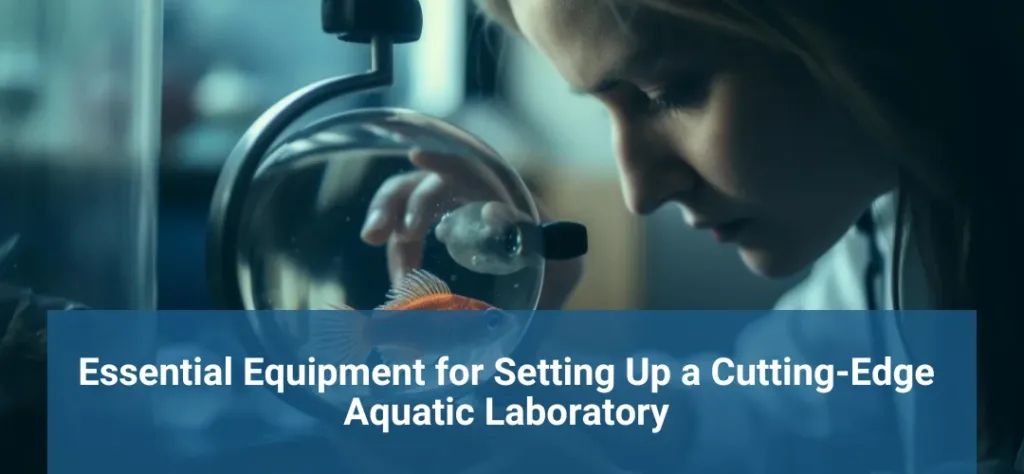Essential Equipment for Setting Up a Cutting-Edge Aquatic Laboratory

Setting up a cutting-edge aquatic laboratory requires careful consideration of a variety of factors, including space, safety, and the scientific goals of the facility. Whether your research focuses on aquaculture, aquatic life sustainability, environmental monitoring, or fish biology, the right equipment is crucial for accurate data collection, ensuring the well-being of aquatic organisms, and facilitating high-quality research. This blog will outline the essential equipment needed to set up an advanced aquatic laboratory that can support diverse scientific endeavors.
1. Water Quality Monitoring Equipment
The foundation of any aquatic laboratory is a precise system for monitoring water quality. The health and survival of aquatic organisms rely heavily on the quality of the water they live in. Water parameters such as temperature, pH, dissolved oxygen, TDGP, conductivity, turbidity, and levels of toxic substances need to be carefully regulated and monitored.
Water Quality Testers
These instruments allow for real-time monitoring of essential parameters. Commonly used devices include:
- pH Sensors: To monitor the acidity or alkalinity of the water, which affects biological processes in aquatic organisms.
- Dissolved Oxygen Meters: To measure oxygen levels, which are crucial for the survival of fish and other aquatic life.
- Total Dissolved Gas Pressure Sensors: To measure total dissolved gases in the water and protect the fish from a gas supersaturation event by shutting off the system pump with a high TDGP level.
- Temperature Sensors: These help in ensuring that the water temperature remains within the optimal range for the species being studied.
- Conductivity Sensors: To measure the ion concentration, which indicate the salinity of the water.
Water Filtration Systems
Water filtration systems remove impurities, pathogens, solids, and excess nutrients that could be harmful to aquatic life. These systems often include mechanical, biological, and chemical filtration components to ensure that the water remains clean and safe for the organisms.
- UV Sterilizers: These are used to kill harmful bacteria, viruses, and algae without the need for chemicals.
- Protein Skimmers: Often used in saltwater aquariums or labs, these remove organic compounds from water before they break down and contribute to poor water quality.
2. Aquatic Housing Systems
The housing systems you use are crucial for keeping your aquatic species in conditions that mimic their natural habitat as closely as possible. These systems must be equipped with features to provide comfort, safety, and suitable environments for different species.
Aquatic Tanks
Various types of tanks can be used depending on the research focus. For example, aquariums for zebrafish breeding require different setups than those used for larger species like Xenopus or marine life. Features to look for include:
- Modular Tanks: These are versatile and can be adapted to suit different research needs.
- Biosecure Tanks: To prevent contamination and ensure the integrity of species-specific environments.
- Material choices: Most zebrafish tanks are made of polycarbonate and are able to be sanitized in a high temperature dishwasher or autoclave. This makes routine cleaning easy and effective.
Racks and Stands
Having reliable and space-efficient racks or stands is essential for organizing your tanks and ensuring the safety of both the species and the equipment. Adjustable shelving can accommodate varying tank sizes and configurations.
Aeration Systems
Aeration systems are necessary to ensure that there is sufficient oxygen in the water. Air pumps, air stones, and diffusers maintain optimal oxygen levels to support healthy aquatic organisms. Certain larval stages of aquatic organisms require aeration for optimal survival and feeding.
3. Environmental Control Systems
Maintaining a stable, controlled environment is crucial in aquatic labs. These systems regulate factors such as temperature, light, humidity, and air circulation to create the best possible living conditions for the organisms.
Climate Control Systems
Temperature regulation is essential for many aquatic species, and an environmental control system will help keep the water at the required temperature. It’s vital to have:
- Heaters and Chillers: To maintain a steady water temperature, especially in research where temperature variations could affect results.
- Temperature Controllers: These ensure the temperature remains constant and provide alarms in case of deviations.
Light Systems
Light is another essential factor to control in an aquatic lab, particularly for photosynthetic species like algae or aquatic plants. Programmable LED lights can simulate natural day-night cycles and can be adjusted to the desired intensity and spectrum.
- LED Lighting: Used to mimic natural sunlight conditions and is energy-efficient.
- Light Timers: To simulate natural light/dark cycles for specific experiments, particularly those involving reproduction or growth.
Humidity and Air Circulation
Humidity control is important to maintain a stable environment. Proper air circulation and ventilation prevent condensation and mold buildup, which could affect both organisms and equipment. Systems such as dehumidifiers and air handling units help keep humidity in check.
4. Specialized Research Equipment
For cutting-edge research, certain high-tech equipment can significantly improve the depth and quality of your findings. These pieces of equipment will assist with various scientific procedures, from genetic analysis to environmental assessments.
Microscopes
Microscopes are fundamental in aquatic research, especially when studying aquatic life at a cellular or microscopic level. The two most commonly used types in aquatic research are:
- Stereo Microscopes: For studying larger specimens like fish embryos or invertebrates.
- Compound Microscopes: For observing cells, tissues, and microorganisms.
Oxygen Tracers
Used in studies related to respiration, microbial activity, and water quality, oxygen tracers measure oxygen consumption rates and other metabolic processes in aquatic organisms. This can provide insights into the health of aquatic ecosystems.
Aquatic Animal Feeding Systems
Automated feeding systems are essential for ensuring that aquatic organisms receive the correct type and amount of food, whether you are studying fish nutrition or behavioral patterns. These systems can be programmed to dispense food at specific times and in the appropriate quantities.
5. Data Management and Recording Systems
In a high-tech laboratory, the collection, analysis, and storage of data are essential for accurate scientific research. The right software and hardware systems will help organize data, track trends, and make your research more efficient.
Laboratory Information Management Systems (LIMS)
LIMS helps in organizing and storing data regarding water quality, the health of organisms, feeding schedules, and more. This system allows you to efficiently track experimental conditions, analyze trends, and generate reports.
Automated Sensors and IoT Integration
Modern aquatic labs often use Internet of Things (IoT) devices to monitor various parameters remotely. This includes sensors that provide real-time data on water quality, temperature, and oxygen levels. Integration of these sensors with LIMS can allow for efficient data tracking and automated adjustments.
6. Safety Equipment
Laboratories dealing with aquatic species must have safety equipment to protect both researchers and organisms. While the focus may be on research, the health and safety of all involved parties are of paramount importance.
Protective Gear
Researchers should have access to personal protective equipment (PPE), including gloves, lab coats, and face shields. These ensure safety while handling chemicals, performing dissections, or working with hazardous aquatic organisms.
Emergency Response Kits
In the event of a water contamination or a spill, it’s essential to have emergency response kits on hand. This includes first aid kits, fire extinguishers, and spill containment systems. Having a clear protocol for emergencies is crucial to maintaining a safe and effective laboratory environment.
Chemical Safety Equipment
If you are using chemicals, such as for water treatment or species preservation, proper chemical safety equipment like fume hoods, chemical storage cabinets, and eyewash stations must be available.
7. Maintenance and Calibration Tools
Maintaining the functionality of the equipment is vital to keep the lab running efficiently. Having the right tools for regular calibration, maintenance, and troubleshooting can save time and prevent equipment downtime.
Calibration Kits
Ensure that your measurement equipment remains accurate by regularly calibrating it. Calibration kits for pH meters, dissolved oxygen meters, and temperature sensors will ensure the accuracy of data.
Backup Power Systems
For a cutting-edge aquatic laboratory, an uninterrupted power supply (UPS) or backup generators are necessary to prevent equipment failure during power outages, especially for systems like water pumps, aerators, and temperature controls.
Conclusion
Setting up a cutting-edge aquatic laboratory involves more than just acquiring the right equipment. It requires careful planning, understanding of the specific research needs, and ensuring that every piece of equipment works harmoniously to create a controlled environment for aquatic species. From water quality monitoring systems to specialized research equipment, maintaining a balance between technology and biological needs is key to ensuring success in aquatic research. The right tools will allow researchers to better understand aquatic life, develop sustainable practices, and contribute to the broader field of aquatic sciences.



